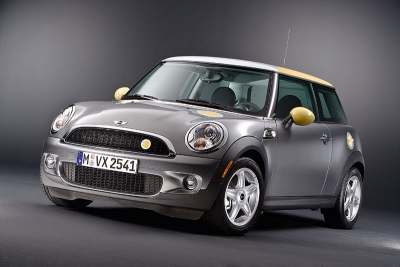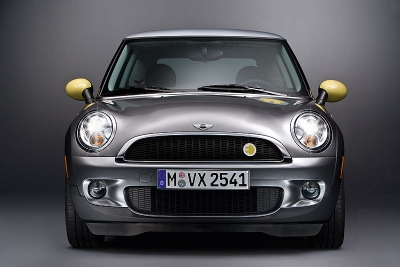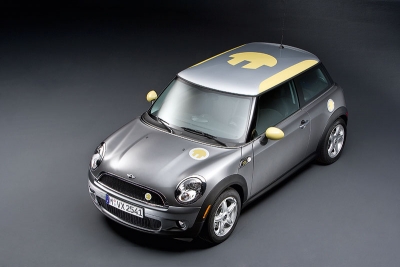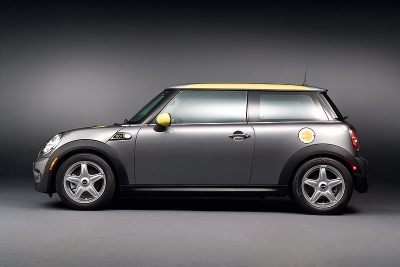Here is the official press release from MINI USA describing the all-electric MINI E that will be hitting out shores in a few weeks. I like the concept. Gives new meaning to “Plug ‘N Play” :).

BMW Group will present the new, electrically-powered MINI E to the global media for the first time at the Los Angeles Auto Show on 19/20 November 2008. 500 MINI E vehicles will then be shipped to the US states of California, New York and New Jersey for testing with private and corporate customers.
The development of the MINI E underlines BMW Groupís commitment to reducing fuel consumption and CO2 emissions in road traffic, without compromise to the driving experience. The 500 cars bound for North America will offer BMW Group the opportunity to evaluate ownership potential for vehicles supplied with an electric power supply. BMW Group aims to begin series production in the medium term of all-electric vehicles as part of the companyís Number ONE strategy.
The cars will be delivered to customers on a one-year lease with an extension option. Monthly lease installments will cover any required technical service including all necessary maintenance and the replacement of wearing parts. At the end of the lease, all of the automobiles belonging to the project will be returned to the BMW Groupís engineering fleet where they will be subjected to comparative tests.
MINI E specification and performance
The MINI Eís electric drive train produces a peak torque of 220 Nm, and power is delivered to the front wheels via a single-stage helical gearbox. This unique engine and transmission arrangement powers the MINI E seamlessly to 62 mph in 8.5 seconds and on to an electronically-limited top speed of 95 mph.Based on the current MINI Hatch, the car will initially be available as a two-seater. The space normally inhabited by rear passengers is reserved for a lithium-ion battery.
When in use in the zero-emissions MINI, the battery unit combines high output with ample storage capacity and remarkable power output. The lithium-ion storage unit will have a maximum capacity of 35 kilowatt hours (kWh) and transmit energy to the electric motor as direct current at a nominal 380 volts. The rechargeable battery is made up of 5,088 cells grouped into 48 modules. These modules are packaged into three battery elements that are compactly arranged inside the MINI E.
The energy storage unitís basic components are based on technologies proven in power supply units for mobile phones and portable computers. The MINI Eís lithium-ion battery can be plugged into all standard power outlets. Its charge time is strongly dependent on the voltage and amperage of the electricity flowing through the grid. In the USA, users can recharge a battery that has been completely drained within a very short period of time using a wallbox that will be supplied as standard with every MINI E.
The wallbox will be installed in the customerís garage, enable higher amperage, and thus provide for extremely short charging times. Wallboxes fully recharge batteries in just two-and-a-half hours. Only lockable garages or similar buildings will qualify as power stations for the MINI E.
Driven by electricity: zero emissions at minimal cost
A full recharge draws a maximum of 28 kilowatt hours of electricity from the grid. Based on the carís range, a kilowatt hour translates into 5.4 miles. Besides the benefit of zero-emissions driving, the MINI E thus offers significant economic advantages over a vehicle powered by a conventional internal combustion engine.The heavy-duty battery delivers its power to an electric motor, which is mounted transversely under the MINI Eís bonnet. This power unit is able to unleash its full thrust from a dead standstill and is complemented by its dynamic deceleration potential, which is directly coupled to the accelerator pedal.
As soon as the driver releases the accelerator pedal, the electric motor acts as a generator. This results in braking force, and the power recovered from the kinetic energy is fed back to the battery. This interaction ensures a comfortable and smooth driving experience. In city traffic, some 75 per cent of all deceleration can be done without the brakes. Making substantial use of this energy regeneration feature extends the carís range by up to 20 percent.
The MINI Eís brake system comes with a newly developed electric pump. Its Electrical Power Assisted Steering (EPS) is the same as the one used in mass-produced MINIs.
The MINI Eís 1,465 kilograms is evenly distributed across the car. Handling safety is ensured by modifications to the suspension system and the carís Dynamic Stability Control (DSC), which is adapted due this modelís specific wheel loads.
Unique styling to mark out the new MINI E
Every MINI E produced for this pilot project will have the same paintwork and bear a serial number on their front bumpers.The MINI Eís coachwork features an exclusive combination of metallic Dark Silver on all panels but the roof, which is clad in Pure Silver. What distinguishes the zero-emissions MINI E is a unique logo in Interchange Yellow, depicting a stylized power plug in the shape of an ìEî set against a silver background. It has been applied to the roof, in smaller dimensions to the front and back, to the charger port lid, the dashboard trim, and ñ combined with the MINI logo ñ to the door jamb, in slightly modified form. The color of the roof edges, mirror housings, interior style cues and seat seams will also match the logoís yellow hue.
Inside, the central gauge and battery level indicator behind the wheel of the MINI E – which replaces the MINIís rev counter – feature yellow lettering against a dark grey background. The battery level is displayed in percentage figures. The central gauge includes an LED display indicating power consumption in red and power recuperation in green.
Maintenance by qualified specialists
The electric driveís high-voltage technology requires that maintenance work be done by qualified personnel using special tools that are not included in MINI service partnersí standard toolboxes. In light of this, a service base will be set up for customers in California, New York and New Jersey, staffed by MINI service engineers that are specially trained to perform maintenance and repair work on the MINI Eís electrical components. In the event of drive malfunction, these experts will provide professional support at the customerís local MINI dealer or the service baseís specially equipped workshop. Technical inspections will take place after 3,000 miles (just under 5,000 kilometers) and at least after six months.Production in Oxford and Munich
The MINI E has already gone through the major phases of product development for mass-produced vehicles and passed numerous crash tests on the way. The MINI Eís energy storage unit emerged completely unscathed from all of the crash tests mandated by US standards, which are especially high.Production of the 500 cars will take place at the companyís Oxford and Munich sites and is scheduled for completion before the end of 2008. MINIís Plant Oxford will be responsible for manufacturing the entire vehicle on the standard production line, with the exception of the drive components and the lithium-ion battery. The units will then be transferred to a specially equipped manufacturing facility situated on BMW plant premises where the electric motor, battery units, performance electronics and transmission will be integrated.



